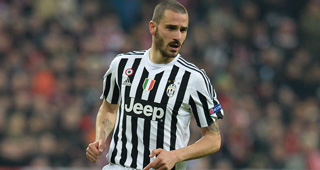Leonardo Bonucci’s midfield pass to set up Emanuele Giaccherini’s goal in the 32nd minute in his side’s opening group stage match against Belgium crystalized the contrasting analysis of this Italian side. They were mentioned as the worst team Italy had ever taken to an international tournament, starting with a lack of traditional creativity as evidenced by Thiago Motta taking the #10 jersey. But as Italy took apart Belgium with their counter attacking and defensive pressing, we snapped back into the moment: this was Italy, led by the Juventus back four, with their backs against the wall, in an international tournament.
Bonucci’s pass was extraordinary in its ordinariness. If the two key skills of a central defender today are cutting off counter attacks before they happen while creating attacks themselves, then Bonucci may be the world’s finest. Italy may lack a traditional playmaker in the final third, but Bonucci’s passing gives Italy both an attacking and defensive structure to build upon for Giacherrini, Eder, Graziano Pelle’s movement and pressing. The numbers tell their own story as Italy only gave up one goal in the group stages, and took apart Spain with the same counter attacking, pressing efficiency as they did Belgium in the opening match. Beyond that, they are as unified as any side in the knockout rounds.
Bonucci’s reunion with Antonio Conte is also significant, as each played an essential role in developing the other's career at Juventus. Bonucci certainly had to earn the move. He began his career at Internazionale in 2005, before being loaned to Treviso and Pisa in Serie B for two seasons in 2007. Yet it was his season with Bari in 2009 where we began to see the traces of the modern day Bonucci - especially in his ability to break an opposition’s defensive organization with one pass. Even then, the backbone of this modern Juventus and current Italy side, especially the pairing of Andrea Barzagli and Bonucci, almost never happened. Any sport is littered with stories of players who were on the verge of leaving a club, but wound up staying and excelling. It is difficult to imagine what Serie A would have looked like in the last five seasons without the Juventus back four.
Before diving further, the construction of the 2009 Bari squad is worth investigating. Bonucci and Andrea Ranocchia made up the central defense that at one point gave up the second fewest goals in Serie A. It was a classic pairing with Bonucci as the brain and Ranocchia’s aerial prowess as the brawn. Just a year apart in age, it is interesting to note the differing paths each player took from that season (highlights of the pair can be found here, and to add to the “sliding doors” nature of the sport, Arsenal scouted the pair in 2009).
The early consensus was that Ranocchia was the better player - or at least, the better defender in the traditional sense. Their manager noted that Bonucci was stronger mentally. And while Bonucci went on to Juventus and much critical acclaim in the following seasons, Ranocchia eventually became the captain of an Inter side struggling to modernize its identity. The 28-year-old was loaned out to Fiorentina last winter. He has appeared just once for Italy in 2016.
Of course, there were reasons beyond just individual talent for why the two players diverged paths. Mobility and vision became essentials for center backs in the pressing era. And as Ranocchia’s aerial ability symbolized Mancini’s defensive approach, Conte’s vision for a modern Juventus style transformed Bonucci into the sweeper of the Juventus and Italian backline. Juventus gave up 57 goals and finished 7th in Serie A the year before Conte, then won Serie A while only giving up 20 goals in Conte’s first season.
Bonucci and Barzagli struggled their first season with Juventus. Bonucci was almost sold the summer before Conte shaped his defense around his vision while ironing out the mental lapses (in an example of how players can develop in four years, this headline in 2012 speaks of Italy winning in spite of Bonucci and Barzagli’s mistakes, and there were questions as to whether Bonucci could be as effective in a two man backline). Bonucci observed how Conte turned the Juventus into a group of soldiers. In return, Bonucci established Conte’s three player defensive identity that defined the manager’s style then with Juventus, now with Italy, and perhaps next season at Chelsea. Juventus gave up just 111 goals in their last five seasons under Conte and Max Allegri. Italy are currently reaping the benefits of that familiarity and stinginess.
Pep Guardiola called Bonucci one of his favorite players, and more transfer rumors are sure to follow this summer. There are obvious links of him reuniting with Conte at Chelsea. And Jose Mourinho, a keen appreciator of center backs, has thrown his name into the list. But alongside a 38-year-old Buffon, 35-year-old Barzagli, and 31-year-old Chiellini, there is still work left to be resolved. A Champions League title would cap off their defensive dominance and Buffon’s career. And of course, there is the immediate challenge of finding holes through Germany’s press, and potentially France, in the coming week.
The initial analysis of Italy’s weaknesses weren’t necessarily wrong. Conte admitted that while the attack was short on quality, the likes of Giaccherini and Pelle made up for it with enthusiasm, energy and tactical knowledge, which are team-wide qualities only appreciated when seen in tandem of eleven players pressing, defending, and counterattacking in unison. Italy did lack in creativity, but there was an attacking structure lead by Bonucci. This is what we all missed when analyzing Conte’s side: the underlying idea defining Italy’s success this summer was built years ago, in 2011.



